Case Analysis: Financial Wealth, SEW, and IPO Underpricing
VerifiedAdded on 2022/10/02
|60
|28123
|400
Report
AI Summary
This report analyzes the phenomenon of IPO underpricing in family firms, drawing from the Academy of Management Journal. It explores the conflicting theoretical explanations and empirical evidence surrounding this issue, particularly the behavioral agency model and prospect theory. The study introduces a two-stage gamble model to reconcile these perspectives, considering how initial socioemotional wealth (SEW) losses influence family owners' decisions to underprice IPO shares. The research examines the trade-off between financial wealth (FW) and SEW, and the dynamic properties of mixed gambles within family firms, supporting theoretical expectations with analysis of 1,807 IPOs in Europe. The report further investigates how family firms frame and evaluate these gambles, especially in the context of business valuations like IPO pricing, and the impact of SEW on strategic decisions.
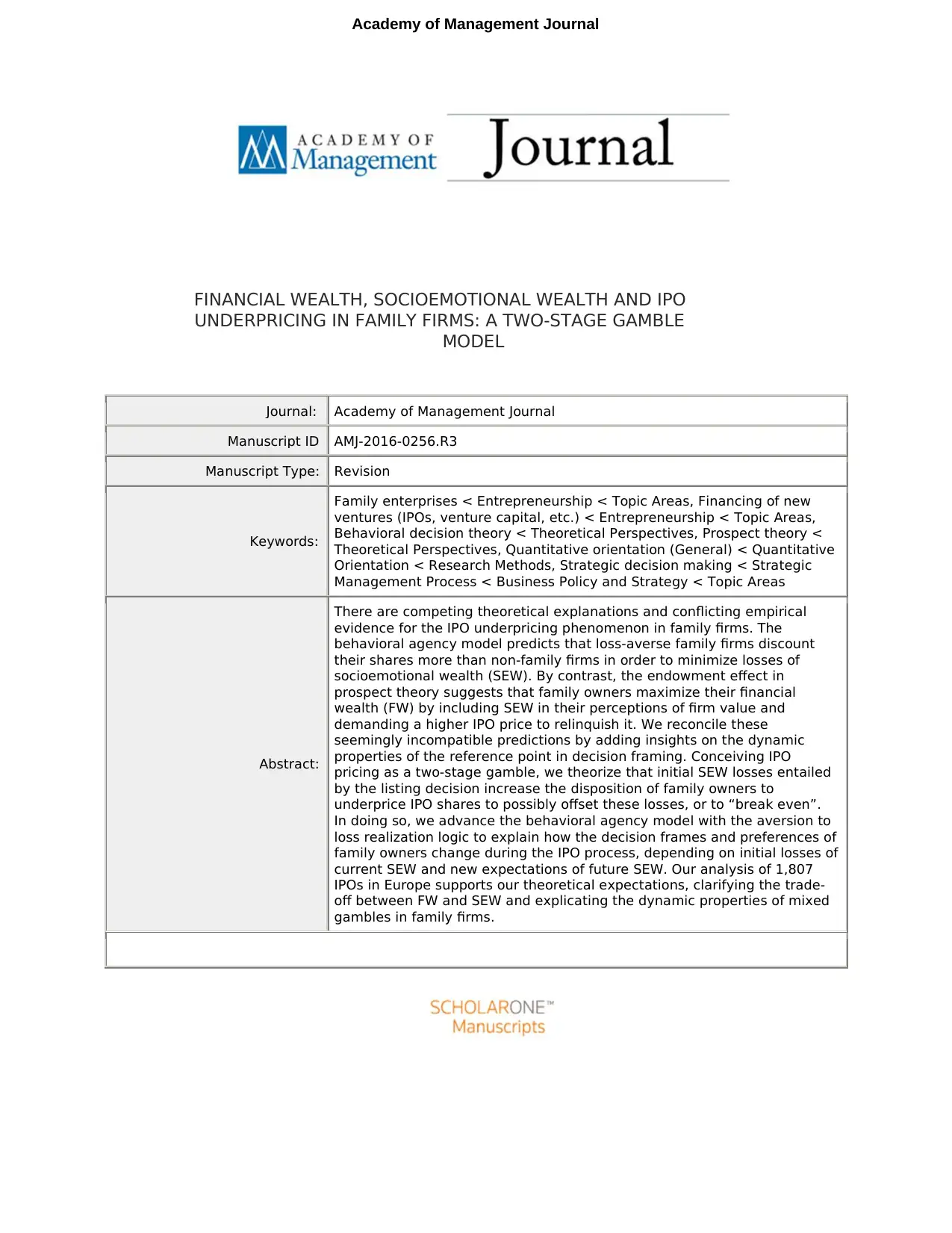
FINANCIAL WEALTH, SOCIOEMOTIONAL WEALTH AND IPO
UNDERPRICING IN FAMILY FIRMS: A TWO-STAGE GAMBLE
MODEL
Journal: Academy of Management Journal
Manuscript ID AMJ-2016-0256.R3
Manuscript Type: Revision
Keywords:
Family enterprises < Entrepreneurship < Topic Areas, Financing of new
ventures (IPOs, venture capital, etc.) < Entrepreneurship < Topic Areas,
Behavioral decision theory < Theoretical Perspectives, Prospect theory <
Theoretical Perspectives, Quantitative orientation (General) < Quantitative
Orientation < Research Methods, Strategic decision making < Strategic
Management Process < Business Policy and Strategy < Topic Areas
Abstract:
There are competing theoretical explanations and conflicting empirical
evidence for the IPO underpricing phenomenon in family firms. The
behavioral agency model predicts that loss-averse family firms discount
their shares more than non-family firms in order to minimize losses of
socioemotional wealth (SEW). By contrast, the endowment effect in
prospect theory suggests that family owners maximize their financial
wealth (FW) by including SEW in their perceptions of firm value and
demanding a higher IPO price to relinquish it. We reconcile these
seemingly incompatible predictions by adding insights on the dynamic
properties of the reference point in decision framing. Conceiving IPO
pricing as a two-stage gamble, we theorize that initial SEW losses entailed
by the listing decision increase the disposition of family owners to
underprice IPO shares to possibly offset these losses, or to “break even”.
In doing so, we advance the behavioral agency model with the aversion to
loss realization logic to explain how the decision frames and preferences of
family owners change during the IPO process, depending on initial losses of
current SEW and new expectations of future SEW. Our analysis of 1,807
IPOs in Europe supports our theoretical expectations, clarifying the trade-
off between FW and SEW and explicating the dynamic properties of mixed
gambles in family firms.
Academy of Management Journal
UNDERPRICING IN FAMILY FIRMS: A TWO-STAGE GAMBLE
MODEL
Journal: Academy of Management Journal
Manuscript ID AMJ-2016-0256.R3
Manuscript Type: Revision
Keywords:
Family enterprises < Entrepreneurship < Topic Areas, Financing of new
ventures (IPOs, venture capital, etc.) < Entrepreneurship < Topic Areas,
Behavioral decision theory < Theoretical Perspectives, Prospect theory <
Theoretical Perspectives, Quantitative orientation (General) < Quantitative
Orientation < Research Methods, Strategic decision making < Strategic
Management Process < Business Policy and Strategy < Topic Areas
Abstract:
There are competing theoretical explanations and conflicting empirical
evidence for the IPO underpricing phenomenon in family firms. The
behavioral agency model predicts that loss-averse family firms discount
their shares more than non-family firms in order to minimize losses of
socioemotional wealth (SEW). By contrast, the endowment effect in
prospect theory suggests that family owners maximize their financial
wealth (FW) by including SEW in their perceptions of firm value and
demanding a higher IPO price to relinquish it. We reconcile these
seemingly incompatible predictions by adding insights on the dynamic
properties of the reference point in decision framing. Conceiving IPO
pricing as a two-stage gamble, we theorize that initial SEW losses entailed
by the listing decision increase the disposition of family owners to
underprice IPO shares to possibly offset these losses, or to “break even”.
In doing so, we advance the behavioral agency model with the aversion to
loss realization logic to explain how the decision frames and preferences of
family owners change during the IPO process, depending on initial losses of
current SEW and new expectations of future SEW. Our analysis of 1,807
IPOs in Europe supports our theoretical expectations, clarifying the trade-
off between FW and SEW and explicating the dynamic properties of mixed
gambles in family firms.
Academy of Management Journal
Paraphrase This Document
Need a fresh take? Get an instant paraphrase of this document with our AI Paraphraser
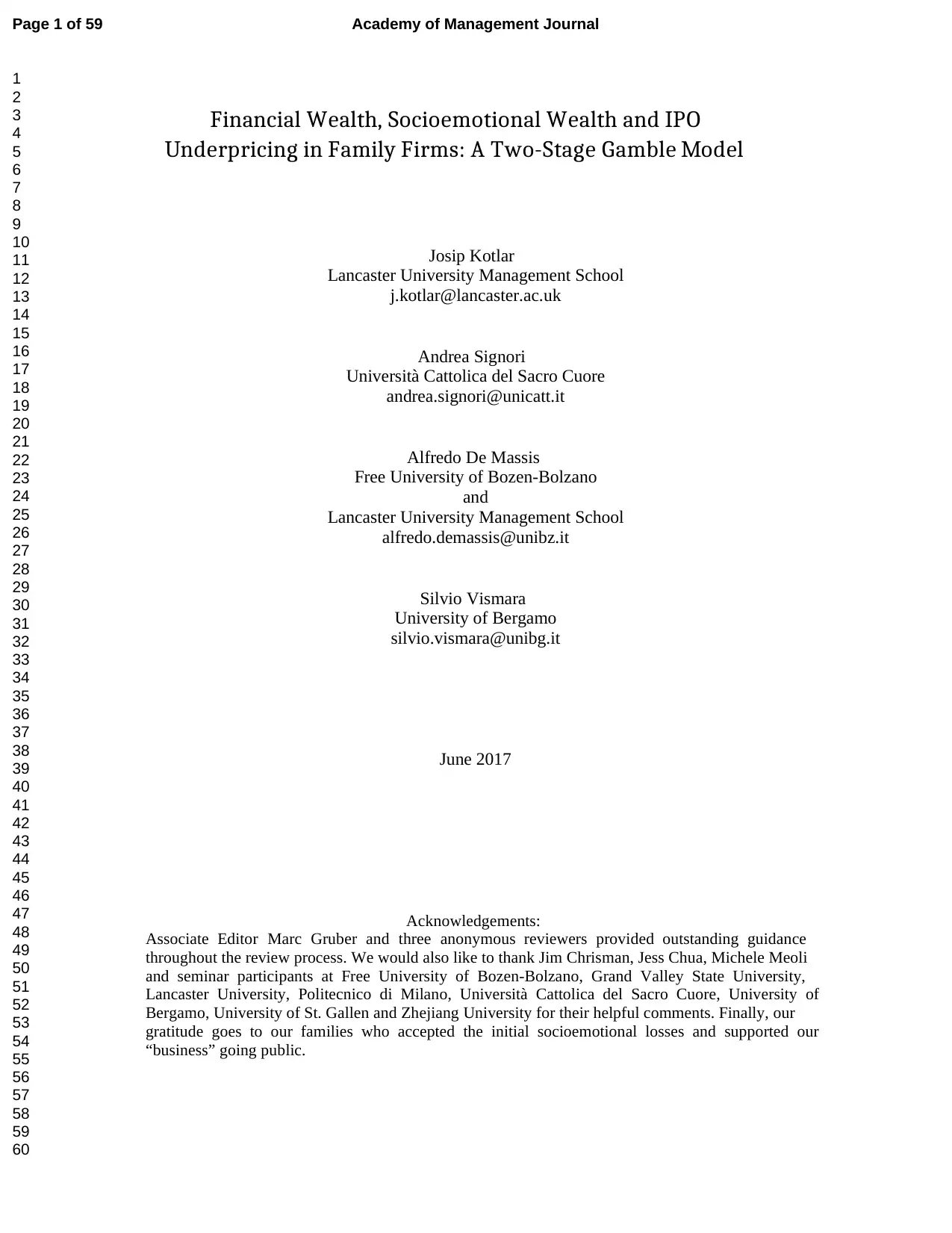
Financial Wealth, Socioemotional Wealth and IPO
Underpricing in Family Firms: A Two-Stage Gamble Model
Josip Kotlar
Lancaster University Management School
j.kotlar@lancaster.ac.uk
Andrea Signori
Università Cattolica del Sacro Cuore
andrea.signori@unicatt.it
Alfredo De Massis
Free University of Bozen-Bolzano
and
Lancaster University Management School
alfredo.demassis@unibz.it
Silvio Vismara
University of Bergamo
silvio.vismara@unibg.it
June 2017
Acknowledgements:
Associate Editor Marc Gruber and three anonymous reviewers provided outstanding guidance
throughout the review process. We would also like to thank Jim Chrisman, Jess Chua, Michele Meoli
and seminar participants at Free University of Bozen-Bolzano, Grand Valley State University,
Lancaster University, Politecnico di Milano, Università Cattolica del Sacro Cuore, University of
Bergamo, University of St. Gallen and Zhejiang University for their helpful comments. Finally, our
gratitude goes to our families who accepted the initial socioemotional losses and supported our
“business” going public.
Page 1 of 59 Academy of Management Journal
1
2
3
4
5
6
7
8
9
10
11
12
13
14
15
16
17
18
19
20
21
22
23
24
25
26
27
28
29
30
31
32
33
34
35
36
37
38
39
40
41
42
43
44
45
46
47
48
49
50
51
52
53
54
55
56
57
58
59
60
Underpricing in Family Firms: A Two-Stage Gamble Model
Josip Kotlar
Lancaster University Management School
j.kotlar@lancaster.ac.uk
Andrea Signori
Università Cattolica del Sacro Cuore
andrea.signori@unicatt.it
Alfredo De Massis
Free University of Bozen-Bolzano
and
Lancaster University Management School
alfredo.demassis@unibz.it
Silvio Vismara
University of Bergamo
silvio.vismara@unibg.it
June 2017
Acknowledgements:
Associate Editor Marc Gruber and three anonymous reviewers provided outstanding guidance
throughout the review process. We would also like to thank Jim Chrisman, Jess Chua, Michele Meoli
and seminar participants at Free University of Bozen-Bolzano, Grand Valley State University,
Lancaster University, Politecnico di Milano, Università Cattolica del Sacro Cuore, University of
Bergamo, University of St. Gallen and Zhejiang University for their helpful comments. Finally, our
gratitude goes to our families who accepted the initial socioemotional losses and supported our
“business” going public.
Page 1 of 59 Academy of Management Journal
1
2
3
4
5
6
7
8
9
10
11
12
13
14
15
16
17
18
19
20
21
22
23
24
25
26
27
28
29
30
31
32
33
34
35
36
37
38
39
40
41
42
43
44
45
46
47
48
49
50
51
52
53
54
55
56
57
58
59
60
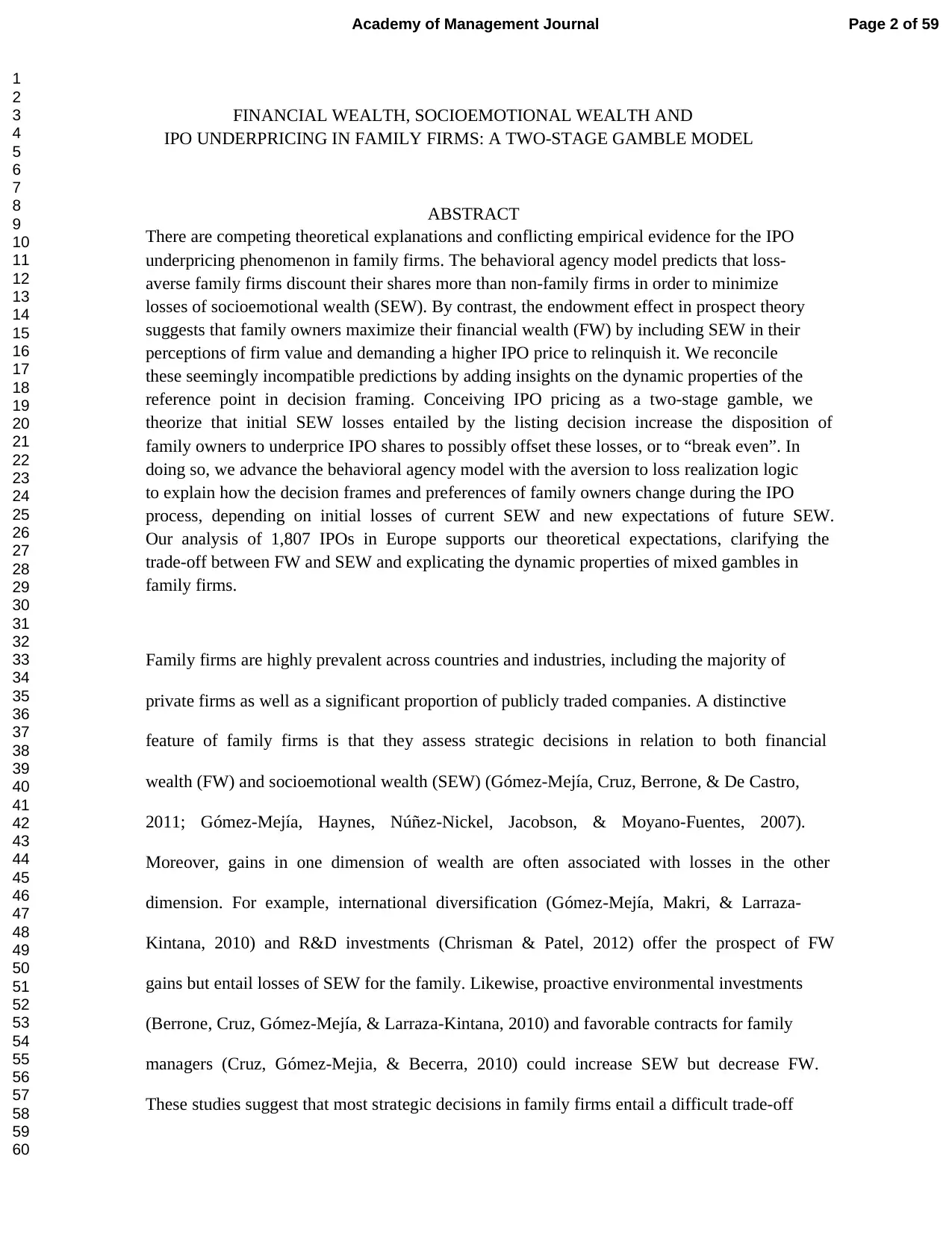
FINANCIAL WEALTH, SOCIOEMOTIONAL WEALTH AND
IPO UNDERPRICING IN FAMILY FIRMS: A TWO-STAGE GAMBLE MODEL
ABSTRACT
There are competing theoretical explanations and conflicting empirical evidence for the IPO
underpricing phenomenon in family firms. The behavioral agency model predicts that loss-
averse family firms discount their shares more than non-family firms in order to minimize
losses of socioemotional wealth (SEW). By contrast, the endowment effect in prospect theory
suggests that family owners maximize their financial wealth (FW) by including SEW in their
perceptions of firm value and demanding a higher IPO price to relinquish it. We reconcile
these seemingly incompatible predictions by adding insights on the dynamic properties of the
reference point in decision framing. Conceiving IPO pricing as a two-stage gamble, we
theorize that initial SEW losses entailed by the listing decision increase the disposition of
family owners to underprice IPO shares to possibly offset these losses, or to “break even”. In
doing so, we advance the behavioral agency model with the aversion to loss realization logic
to explain how the decision frames and preferences of family owners change during the IPO
process, depending on initial losses of current SEW and new expectations of future SEW.
Our analysis of 1,807 IPOs in Europe supports our theoretical expectations, clarifying the
trade-off between FW and SEW and explicating the dynamic properties of mixed gambles in
family firms.
Family firms are highly prevalent across countries and industries, including the majority of
private firms as well as a significant proportion of publicly traded companies. A distinctive
feature of family firms is that they assess strategic decisions in relation to both financial
wealth (FW) and socioemotional wealth (SEW) (Gómez-Mejía, Cruz, Berrone, & De Castro,
2011; Gómez-Mejía, Haynes, Núñez-Nickel, Jacobson, & Moyano-Fuentes, 2007).
Moreover, gains in one dimension of wealth are often associated with losses in the other
dimension. For example, international diversification (Gómez-Mejía, Makri, & Larraza-
Kintana, 2010) and R&D investments (Chrisman & Patel, 2012) offer the prospect of FW
gains but entail losses of SEW for the family. Likewise, proactive environmental investments
(Berrone, Cruz, Gómez-Mejía, & Larraza-Kintana, 2010) and favorable contracts for family
managers (Cruz, Gómez-Mejia, & Becerra, 2010) could increase SEW but decrease FW.
These studies suggest that most strategic decisions in family firms entail a difficult trade-off
Page 2 of 59Academy of Management Journal
1
2
3
4
5
6
7
8
9
10
11
12
13
14
15
16
17
18
19
20
21
22
23
24
25
26
27
28
29
30
31
32
33
34
35
36
37
38
39
40
41
42
43
44
45
46
47
48
49
50
51
52
53
54
55
56
57
58
59
60
IPO UNDERPRICING IN FAMILY FIRMS: A TWO-STAGE GAMBLE MODEL
ABSTRACT
There are competing theoretical explanations and conflicting empirical evidence for the IPO
underpricing phenomenon in family firms. The behavioral agency model predicts that loss-
averse family firms discount their shares more than non-family firms in order to minimize
losses of socioemotional wealth (SEW). By contrast, the endowment effect in prospect theory
suggests that family owners maximize their financial wealth (FW) by including SEW in their
perceptions of firm value and demanding a higher IPO price to relinquish it. We reconcile
these seemingly incompatible predictions by adding insights on the dynamic properties of the
reference point in decision framing. Conceiving IPO pricing as a two-stage gamble, we
theorize that initial SEW losses entailed by the listing decision increase the disposition of
family owners to underprice IPO shares to possibly offset these losses, or to “break even”. In
doing so, we advance the behavioral agency model with the aversion to loss realization logic
to explain how the decision frames and preferences of family owners change during the IPO
process, depending on initial losses of current SEW and new expectations of future SEW.
Our analysis of 1,807 IPOs in Europe supports our theoretical expectations, clarifying the
trade-off between FW and SEW and explicating the dynamic properties of mixed gambles in
family firms.
Family firms are highly prevalent across countries and industries, including the majority of
private firms as well as a significant proportion of publicly traded companies. A distinctive
feature of family firms is that they assess strategic decisions in relation to both financial
wealth (FW) and socioemotional wealth (SEW) (Gómez-Mejía, Cruz, Berrone, & De Castro,
2011; Gómez-Mejía, Haynes, Núñez-Nickel, Jacobson, & Moyano-Fuentes, 2007).
Moreover, gains in one dimension of wealth are often associated with losses in the other
dimension. For example, international diversification (Gómez-Mejía, Makri, & Larraza-
Kintana, 2010) and R&D investments (Chrisman & Patel, 2012) offer the prospect of FW
gains but entail losses of SEW for the family. Likewise, proactive environmental investments
(Berrone, Cruz, Gómez-Mejía, & Larraza-Kintana, 2010) and favorable contracts for family
managers (Cruz, Gómez-Mejia, & Becerra, 2010) could increase SEW but decrease FW.
These studies suggest that most strategic decisions in family firms entail a difficult trade-off
Page 2 of 59Academy of Management Journal
1
2
3
4
5
6
7
8
9
10
11
12
13
14
15
16
17
18
19
20
21
22
23
24
25
26
27
28
29
30
31
32
33
34
35
36
37
38
39
40
41
42
43
44
45
46
47
48
49
50
51
52
53
54
55
56
57
58
59
60
⊘ This is a preview!⊘
Do you want full access?
Subscribe today to unlock all pages.

Trusted by 1+ million students worldwide
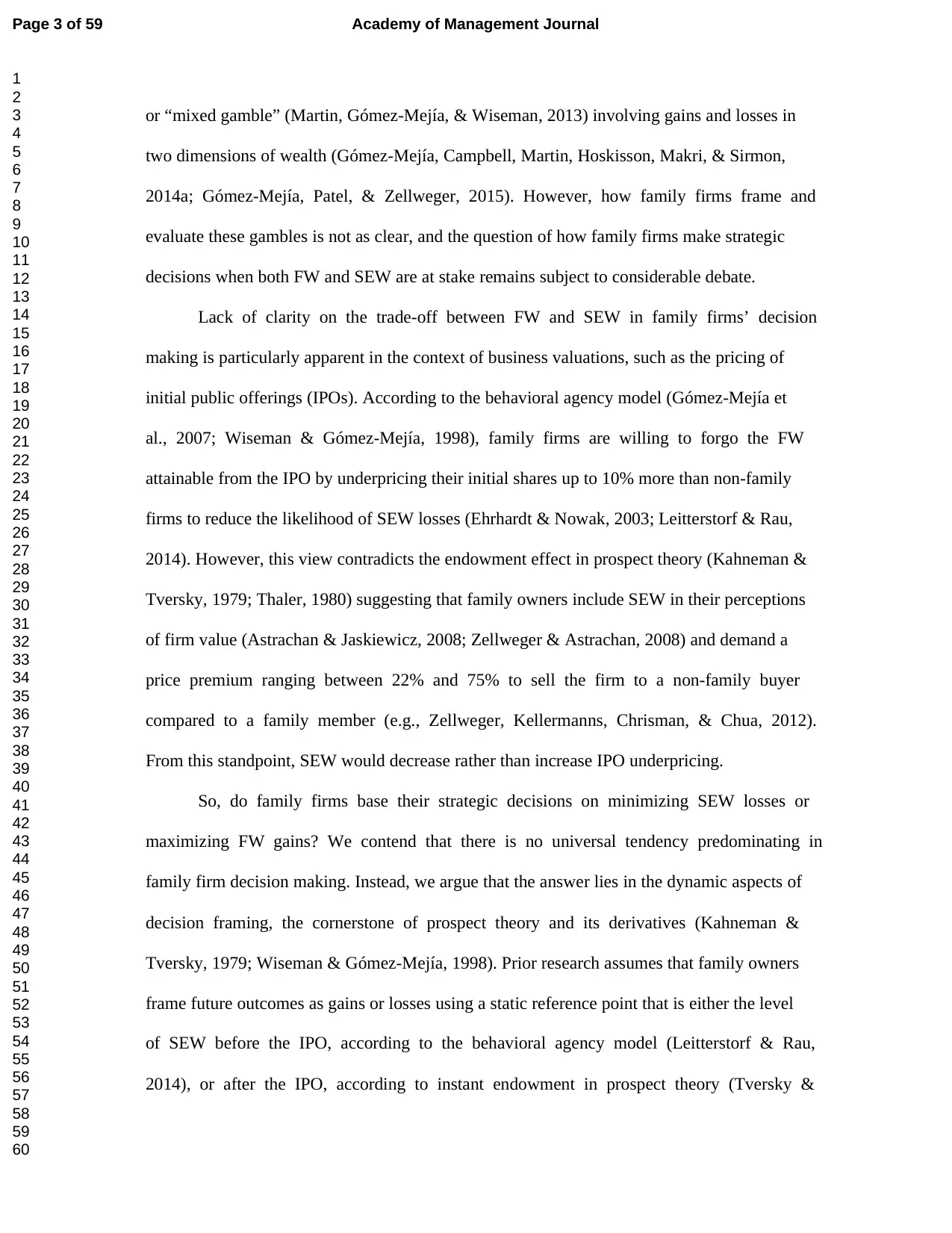
or “mixed gamble” (Martin, Gómez-Mejía, & Wiseman, 2013) involving gains and losses in
two dimensions of wealth (Gómez-Mejía, Campbell, Martin, Hoskisson, Makri, & Sirmon,
2014a; Gómez-Mejía, Patel, & Zellweger, 2015). However, how family firms frame and
evaluate these gambles is not as clear, and the question of how family firms make strategic
decisions when both FW and SEW are at stake remains subject to considerable debate.
Lack of clarity on the trade-off between FW and SEW in family firms’ decision
making is particularly apparent in the context of business valuations, such as the pricing of
initial public offerings (IPOs). According to the behavioral agency model (Gómez-Mejía et
al., 2007; Wiseman & Gómez-Mejía, 1998), family firms are willing to forgo the FW
attainable from the IPO by underpricing their initial shares up to 10% more than non-family
firms to reduce the likelihood of SEW losses (Ehrhardt & Nowak, 2003; Leitterstorf & Rau,
2014). However, this view contradicts the endowment effect in prospect theory (Kahneman &
Tversky, 1979; Thaler, 1980) suggesting that family owners include SEW in their perceptions
of firm value (Astrachan & Jaskiewicz, 2008; Zellweger & Astrachan, 2008) and demand a
price premium ranging between 22% and 75% to sell the firm to a non-family buyer
compared to a family member (e.g., Zellweger, Kellermanns, Chrisman, & Chua, 2012).
From this standpoint, SEW would decrease rather than increase IPO underpricing.
So, do family firms base their strategic decisions on minimizing SEW losses or
maximizing FW gains? We contend that there is no universal tendency predominating in
family firm decision making. Instead, we argue that the answer lies in the dynamic aspects of
decision framing, the cornerstone of prospect theory and its derivatives (Kahneman &
Tversky, 1979; Wiseman & Gómez-Mejía, 1998). Prior research assumes that family owners
frame future outcomes as gains or losses using a static reference point that is either the level
of SEW before the IPO, according to the behavioral agency model (Leitterstorf & Rau,
2014), or after the IPO, according to instant endowment in prospect theory (Tversky &
Page 3 of 59 Academy of Management Journal
1
2
3
4
5
6
7
8
9
10
11
12
13
14
15
16
17
18
19
20
21
22
23
24
25
26
27
28
29
30
31
32
33
34
35
36
37
38
39
40
41
42
43
44
45
46
47
48
49
50
51
52
53
54
55
56
57
58
59
60
two dimensions of wealth (Gómez-Mejía, Campbell, Martin, Hoskisson, Makri, & Sirmon,
2014a; Gómez-Mejía, Patel, & Zellweger, 2015). However, how family firms frame and
evaluate these gambles is not as clear, and the question of how family firms make strategic
decisions when both FW and SEW are at stake remains subject to considerable debate.
Lack of clarity on the trade-off between FW and SEW in family firms’ decision
making is particularly apparent in the context of business valuations, such as the pricing of
initial public offerings (IPOs). According to the behavioral agency model (Gómez-Mejía et
al., 2007; Wiseman & Gómez-Mejía, 1998), family firms are willing to forgo the FW
attainable from the IPO by underpricing their initial shares up to 10% more than non-family
firms to reduce the likelihood of SEW losses (Ehrhardt & Nowak, 2003; Leitterstorf & Rau,
2014). However, this view contradicts the endowment effect in prospect theory (Kahneman &
Tversky, 1979; Thaler, 1980) suggesting that family owners include SEW in their perceptions
of firm value (Astrachan & Jaskiewicz, 2008; Zellweger & Astrachan, 2008) and demand a
price premium ranging between 22% and 75% to sell the firm to a non-family buyer
compared to a family member (e.g., Zellweger, Kellermanns, Chrisman, & Chua, 2012).
From this standpoint, SEW would decrease rather than increase IPO underpricing.
So, do family firms base their strategic decisions on minimizing SEW losses or
maximizing FW gains? We contend that there is no universal tendency predominating in
family firm decision making. Instead, we argue that the answer lies in the dynamic aspects of
decision framing, the cornerstone of prospect theory and its derivatives (Kahneman &
Tversky, 1979; Wiseman & Gómez-Mejía, 1998). Prior research assumes that family owners
frame future outcomes as gains or losses using a static reference point that is either the level
of SEW before the IPO, according to the behavioral agency model (Leitterstorf & Rau,
2014), or after the IPO, according to instant endowment in prospect theory (Tversky &
Page 3 of 59 Academy of Management Journal
1
2
3
4
5
6
7
8
9
10
11
12
13
14
15
16
17
18
19
20
21
22
23
24
25
26
27
28
29
30
31
32
33
34
35
36
37
38
39
40
41
42
43
44
45
46
47
48
49
50
51
52
53
54
55
56
57
58
59
60
Paraphrase This Document
Need a fresh take? Get an instant paraphrase of this document with our AI Paraphraser
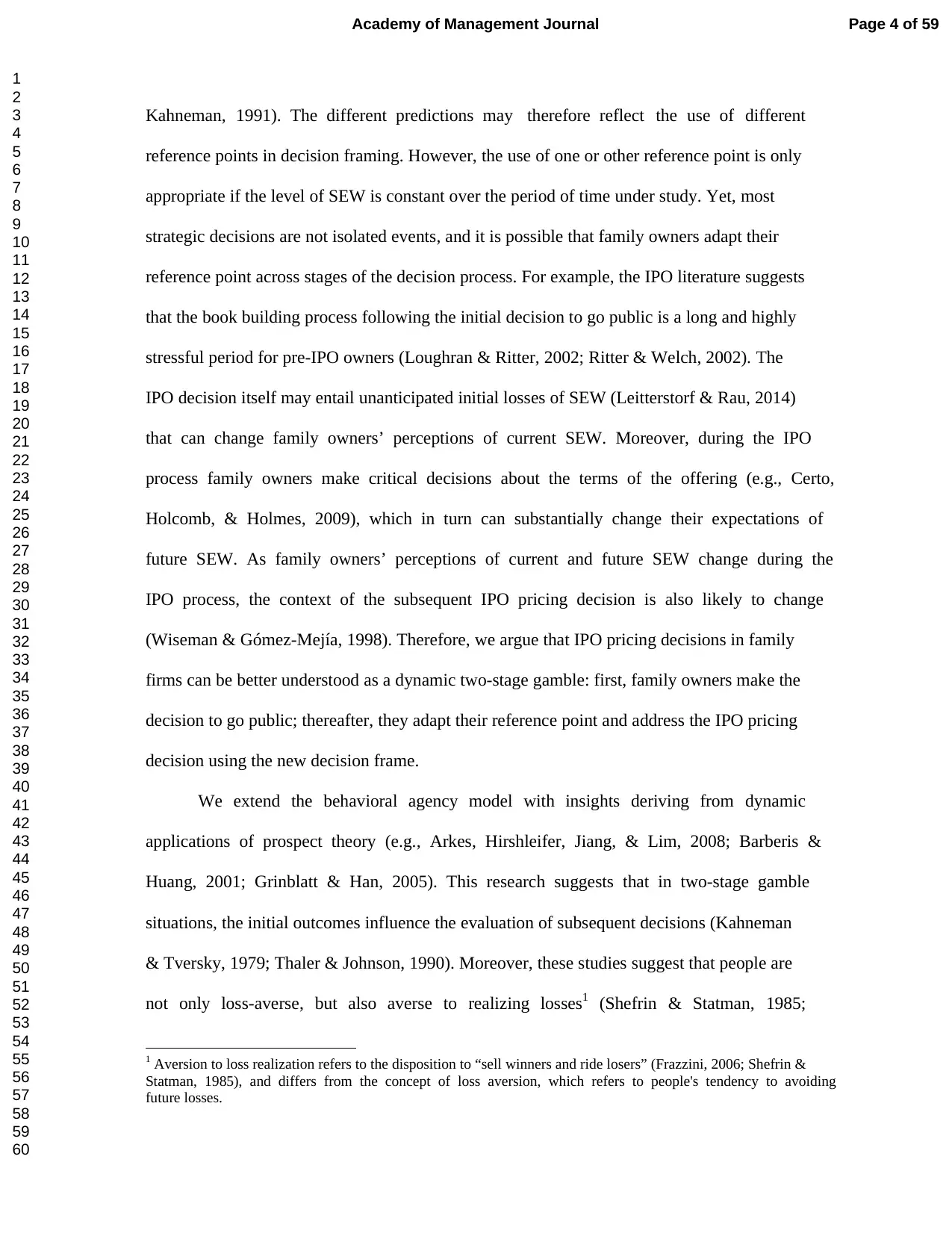
Kahneman, 1991). The different predictions may therefore reflect the use of different
reference points in decision framing. However, the use of one or other reference point is only
appropriate if the level of SEW is constant over the period of time under study. Yet, most
strategic decisions are not isolated events, and it is possible that family owners adapt their
reference point across stages of the decision process. For example, the IPO literature suggests
that the book building process following the initial decision to go public is a long and highly
stressful period for pre-IPO owners (Loughran & Ritter, 2002; Ritter & Welch, 2002). The
IPO decision itself may entail unanticipated initial losses of SEW (Leitterstorf & Rau, 2014)
that can change family owners’ perceptions of current SEW. Moreover, during the IPO
process family owners make critical decisions about the terms of the offering (e.g., Certo,
Holcomb, & Holmes, 2009), which in turn can substantially change their expectations of
future SEW. As family owners’ perceptions of current and future SEW change during the
IPO process, the context of the subsequent IPO pricing decision is also likely to change
(Wiseman & Gómez-Mejía, 1998). Therefore, we argue that IPO pricing decisions in family
firms can be better understood as a dynamic two-stage gamble: first, family owners make the
decision to go public; thereafter, they adapt their reference point and address the IPO pricing
decision using the new decision frame.
We extend the behavioral agency model with insights deriving from dynamic
applications of prospect theory (e.g., Arkes, Hirshleifer, Jiang, & Lim, 2008; Barberis &
Huang, 2001; Grinblatt & Han, 2005). This research suggests that in two-stage gamble
situations, the initial outcomes influence the evaluation of subsequent decisions (Kahneman
& Tversky, 1979; Thaler & Johnson, 1990). Moreover, these studies suggest that people are
not only loss-averse, but also averse to realizing losses1 (Shefrin & Statman, 1985;
1 Aversion to loss realization refers to the disposition to “sell winners and ride losers” (Frazzini, 2006; Shefrin &
Statman, 1985), and differs from the concept of loss aversion, which refers to people's tendency to avoiding
future losses.
Page 4 of 59Academy of Management Journal
1
2
3
4
5
6
7
8
9
10
11
12
13
14
15
16
17
18
19
20
21
22
23
24
25
26
27
28
29
30
31
32
33
34
35
36
37
38
39
40
41
42
43
44
45
46
47
48
49
50
51
52
53
54
55
56
57
58
59
60
reference points in decision framing. However, the use of one or other reference point is only
appropriate if the level of SEW is constant over the period of time under study. Yet, most
strategic decisions are not isolated events, and it is possible that family owners adapt their
reference point across stages of the decision process. For example, the IPO literature suggests
that the book building process following the initial decision to go public is a long and highly
stressful period for pre-IPO owners (Loughran & Ritter, 2002; Ritter & Welch, 2002). The
IPO decision itself may entail unanticipated initial losses of SEW (Leitterstorf & Rau, 2014)
that can change family owners’ perceptions of current SEW. Moreover, during the IPO
process family owners make critical decisions about the terms of the offering (e.g., Certo,
Holcomb, & Holmes, 2009), which in turn can substantially change their expectations of
future SEW. As family owners’ perceptions of current and future SEW change during the
IPO process, the context of the subsequent IPO pricing decision is also likely to change
(Wiseman & Gómez-Mejía, 1998). Therefore, we argue that IPO pricing decisions in family
firms can be better understood as a dynamic two-stage gamble: first, family owners make the
decision to go public; thereafter, they adapt their reference point and address the IPO pricing
decision using the new decision frame.
We extend the behavioral agency model with insights deriving from dynamic
applications of prospect theory (e.g., Arkes, Hirshleifer, Jiang, & Lim, 2008; Barberis &
Huang, 2001; Grinblatt & Han, 2005). This research suggests that in two-stage gamble
situations, the initial outcomes influence the evaluation of subsequent decisions (Kahneman
& Tversky, 1979; Thaler & Johnson, 1990). Moreover, these studies suggest that people are
not only loss-averse, but also averse to realizing losses1 (Shefrin & Statman, 1985;
1 Aversion to loss realization refers to the disposition to “sell winners and ride losers” (Frazzini, 2006; Shefrin &
Statman, 1985), and differs from the concept of loss aversion, which refers to people's tendency to avoiding
future losses.
Page 4 of 59Academy of Management Journal
1
2
3
4
5
6
7
8
9
10
11
12
13
14
15
16
17
18
19
20
21
22
23
24
25
26
27
28
29
30
31
32
33
34
35
36
37
38
39
40
41
42
43
44
45
46
47
48
49
50
51
52
53
54
55
56
57
58
59
60
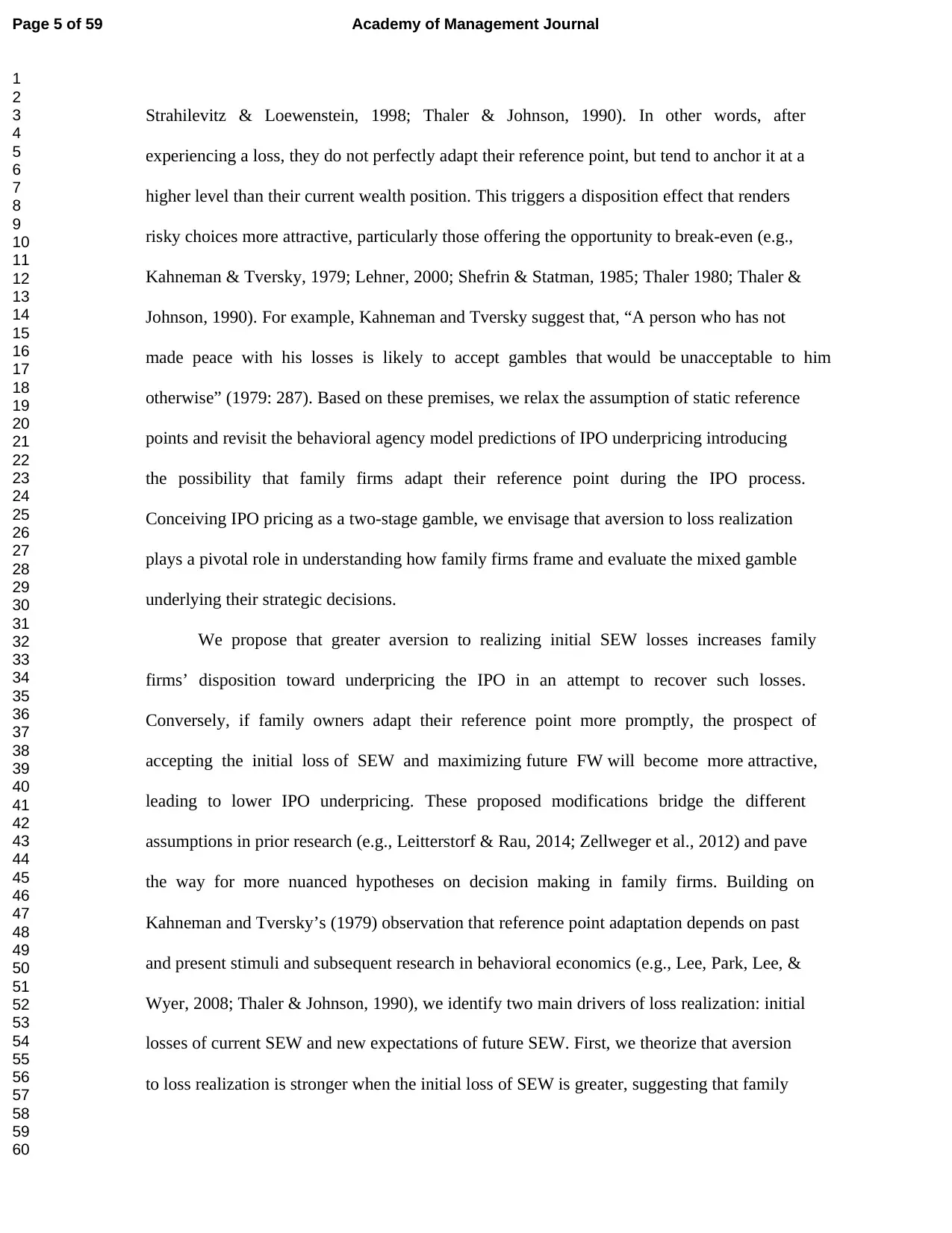
Strahilevitz & Loewenstein, 1998; Thaler & Johnson, 1990). In other words, after
experiencing a loss, they do not perfectly adapt their reference point, but tend to anchor it at a
higher level than their current wealth position. This triggers a disposition effect that renders
risky choices more attractive, particularly those offering the opportunity to break-even (e.g.,
Kahneman & Tversky, 1979; Lehner, 2000; Shefrin & Statman, 1985; Thaler 1980; Thaler &
Johnson, 1990). For example, Kahneman and Tversky suggest that, “A person who has not
made peace with his losses is likely to accept gambles that would be unacceptable to him
otherwise” (1979: 287). Based on these premises, we relax the assumption of static reference
points and revisit the behavioral agency model predictions of IPO underpricing introducing
the possibility that family firms adapt their reference point during the IPO process.
Conceiving IPO pricing as a two-stage gamble, we envisage that aversion to loss realization
plays a pivotal role in understanding how family firms frame and evaluate the mixed gamble
underlying their strategic decisions.
We propose that greater aversion to realizing initial SEW losses increases family
firms’ disposition toward underpricing the IPO in an attempt to recover such losses.
Conversely, if family owners adapt their reference point more promptly, the prospect of
accepting the initial loss of SEW and maximizing future FW will become more attractive,
leading to lower IPO underpricing. These proposed modifications bridge the different
assumptions in prior research (e.g., Leitterstorf & Rau, 2014; Zellweger et al., 2012) and pave
the way for more nuanced hypotheses on decision making in family firms. Building on
Kahneman and Tversky’s (1979) observation that reference point adaptation depends on past
and present stimuli and subsequent research in behavioral economics (e.g., Lee, Park, Lee, &
Wyer, 2008; Thaler & Johnson, 1990), we identify two main drivers of loss realization: initial
losses of current SEW and new expectations of future SEW. First, we theorize that aversion
to loss realization is stronger when the initial loss of SEW is greater, suggesting that family
Page 5 of 59 Academy of Management Journal
1
2
3
4
5
6
7
8
9
10
11
12
13
14
15
16
17
18
19
20
21
22
23
24
25
26
27
28
29
30
31
32
33
34
35
36
37
38
39
40
41
42
43
44
45
46
47
48
49
50
51
52
53
54
55
56
57
58
59
60
experiencing a loss, they do not perfectly adapt their reference point, but tend to anchor it at a
higher level than their current wealth position. This triggers a disposition effect that renders
risky choices more attractive, particularly those offering the opportunity to break-even (e.g.,
Kahneman & Tversky, 1979; Lehner, 2000; Shefrin & Statman, 1985; Thaler 1980; Thaler &
Johnson, 1990). For example, Kahneman and Tversky suggest that, “A person who has not
made peace with his losses is likely to accept gambles that would be unacceptable to him
otherwise” (1979: 287). Based on these premises, we relax the assumption of static reference
points and revisit the behavioral agency model predictions of IPO underpricing introducing
the possibility that family firms adapt their reference point during the IPO process.
Conceiving IPO pricing as a two-stage gamble, we envisage that aversion to loss realization
plays a pivotal role in understanding how family firms frame and evaluate the mixed gamble
underlying their strategic decisions.
We propose that greater aversion to realizing initial SEW losses increases family
firms’ disposition toward underpricing the IPO in an attempt to recover such losses.
Conversely, if family owners adapt their reference point more promptly, the prospect of
accepting the initial loss of SEW and maximizing future FW will become more attractive,
leading to lower IPO underpricing. These proposed modifications bridge the different
assumptions in prior research (e.g., Leitterstorf & Rau, 2014; Zellweger et al., 2012) and pave
the way for more nuanced hypotheses on decision making in family firms. Building on
Kahneman and Tversky’s (1979) observation that reference point adaptation depends on past
and present stimuli and subsequent research in behavioral economics (e.g., Lee, Park, Lee, &
Wyer, 2008; Thaler & Johnson, 1990), we identify two main drivers of loss realization: initial
losses of current SEW and new expectations of future SEW. First, we theorize that aversion
to loss realization is stronger when the initial loss of SEW is greater, suggesting that family
Page 5 of 59 Academy of Management Journal
1
2
3
4
5
6
7
8
9
10
11
12
13
14
15
16
17
18
19
20
21
22
23
24
25
26
27
28
29
30
31
32
33
34
35
36
37
38
39
40
41
42
43
44
45
46
47
48
49
50
51
52
53
54
55
56
57
58
59
60
⊘ This is a preview!⊘
Do you want full access?
Subscribe today to unlock all pages.

Trusted by 1+ million students worldwide
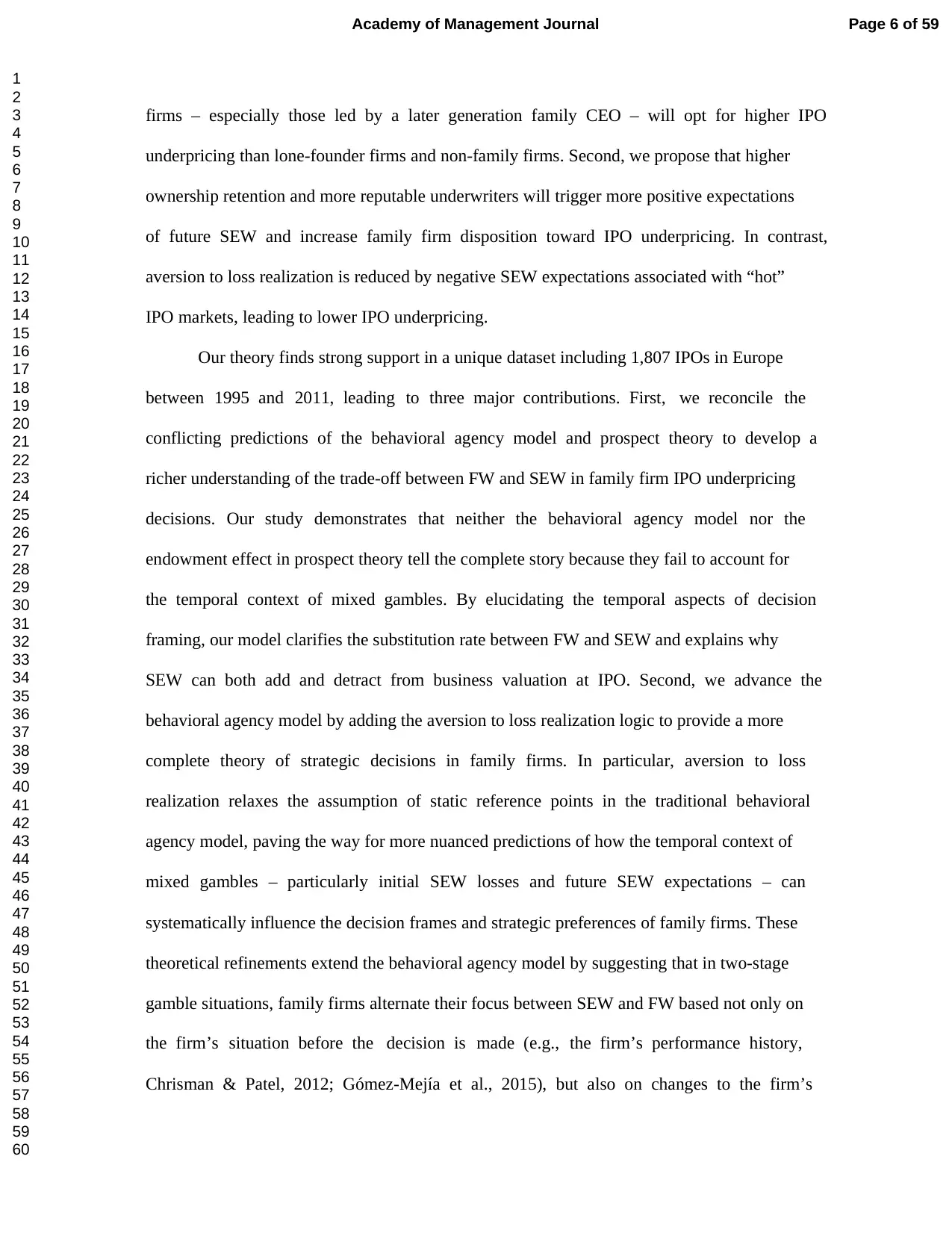
firms – especially those led by a later generation family CEO – will opt for higher IPO
underpricing than lone-founder firms and non-family firms. Second, we propose that higher
ownership retention and more reputable underwriters will trigger more positive expectations
of future SEW and increase family firm disposition toward IPO underpricing. In contrast,
aversion to loss realization is reduced by negative SEW expectations associated with “hot”
IPO markets, leading to lower IPO underpricing.
Our theory finds strong support in a unique dataset including 1,807 IPOs in Europe
between 1995 and 2011, leading to three major contributions. First, we reconcile the
conflicting predictions of the behavioral agency model and prospect theory to develop a
richer understanding of the trade-off between FW and SEW in family firm IPO underpricing
decisions. Our study demonstrates that neither the behavioral agency model nor the
endowment effect in prospect theory tell the complete story because they fail to account for
the temporal context of mixed gambles. By elucidating the temporal aspects of decision
framing, our model clarifies the substitution rate between FW and SEW and explains why
SEW can both add and detract from business valuation at IPO. Second, we advance the
behavioral agency model by adding the aversion to loss realization logic to provide a more
complete theory of strategic decisions in family firms. In particular, aversion to loss
realization relaxes the assumption of static reference points in the traditional behavioral
agency model, paving the way for more nuanced predictions of how the temporal context of
mixed gambles – particularly initial SEW losses and future SEW expectations – can
systematically influence the decision frames and strategic preferences of family firms. These
theoretical refinements extend the behavioral agency model by suggesting that in two-stage
gamble situations, family firms alternate their focus between SEW and FW based not only on
the firm’s situation before the decision is made (e.g., the firm’s performance history,
Chrisman & Patel, 2012; Gómez-Mejía et al., 2015), but also on changes to the firm’s
Page 6 of 59Academy of Management Journal
1
2
3
4
5
6
7
8
9
10
11
12
13
14
15
16
17
18
19
20
21
22
23
24
25
26
27
28
29
30
31
32
33
34
35
36
37
38
39
40
41
42
43
44
45
46
47
48
49
50
51
52
53
54
55
56
57
58
59
60
underpricing than lone-founder firms and non-family firms. Second, we propose that higher
ownership retention and more reputable underwriters will trigger more positive expectations
of future SEW and increase family firm disposition toward IPO underpricing. In contrast,
aversion to loss realization is reduced by negative SEW expectations associated with “hot”
IPO markets, leading to lower IPO underpricing.
Our theory finds strong support in a unique dataset including 1,807 IPOs in Europe
between 1995 and 2011, leading to three major contributions. First, we reconcile the
conflicting predictions of the behavioral agency model and prospect theory to develop a
richer understanding of the trade-off between FW and SEW in family firm IPO underpricing
decisions. Our study demonstrates that neither the behavioral agency model nor the
endowment effect in prospect theory tell the complete story because they fail to account for
the temporal context of mixed gambles. By elucidating the temporal aspects of decision
framing, our model clarifies the substitution rate between FW and SEW and explains why
SEW can both add and detract from business valuation at IPO. Second, we advance the
behavioral agency model by adding the aversion to loss realization logic to provide a more
complete theory of strategic decisions in family firms. In particular, aversion to loss
realization relaxes the assumption of static reference points in the traditional behavioral
agency model, paving the way for more nuanced predictions of how the temporal context of
mixed gambles – particularly initial SEW losses and future SEW expectations – can
systematically influence the decision frames and strategic preferences of family firms. These
theoretical refinements extend the behavioral agency model by suggesting that in two-stage
gamble situations, family firms alternate their focus between SEW and FW based not only on
the firm’s situation before the decision is made (e.g., the firm’s performance history,
Chrisman & Patel, 2012; Gómez-Mejía et al., 2015), but also on changes to the firm’s
Page 6 of 59Academy of Management Journal
1
2
3
4
5
6
7
8
9
10
11
12
13
14
15
16
17
18
19
20
21
22
23
24
25
26
27
28
29
30
31
32
33
34
35
36
37
38
39
40
41
42
43
44
45
46
47
48
49
50
51
52
53
54
55
56
57
58
59
60
Paraphrase This Document
Need a fresh take? Get an instant paraphrase of this document with our AI Paraphraser
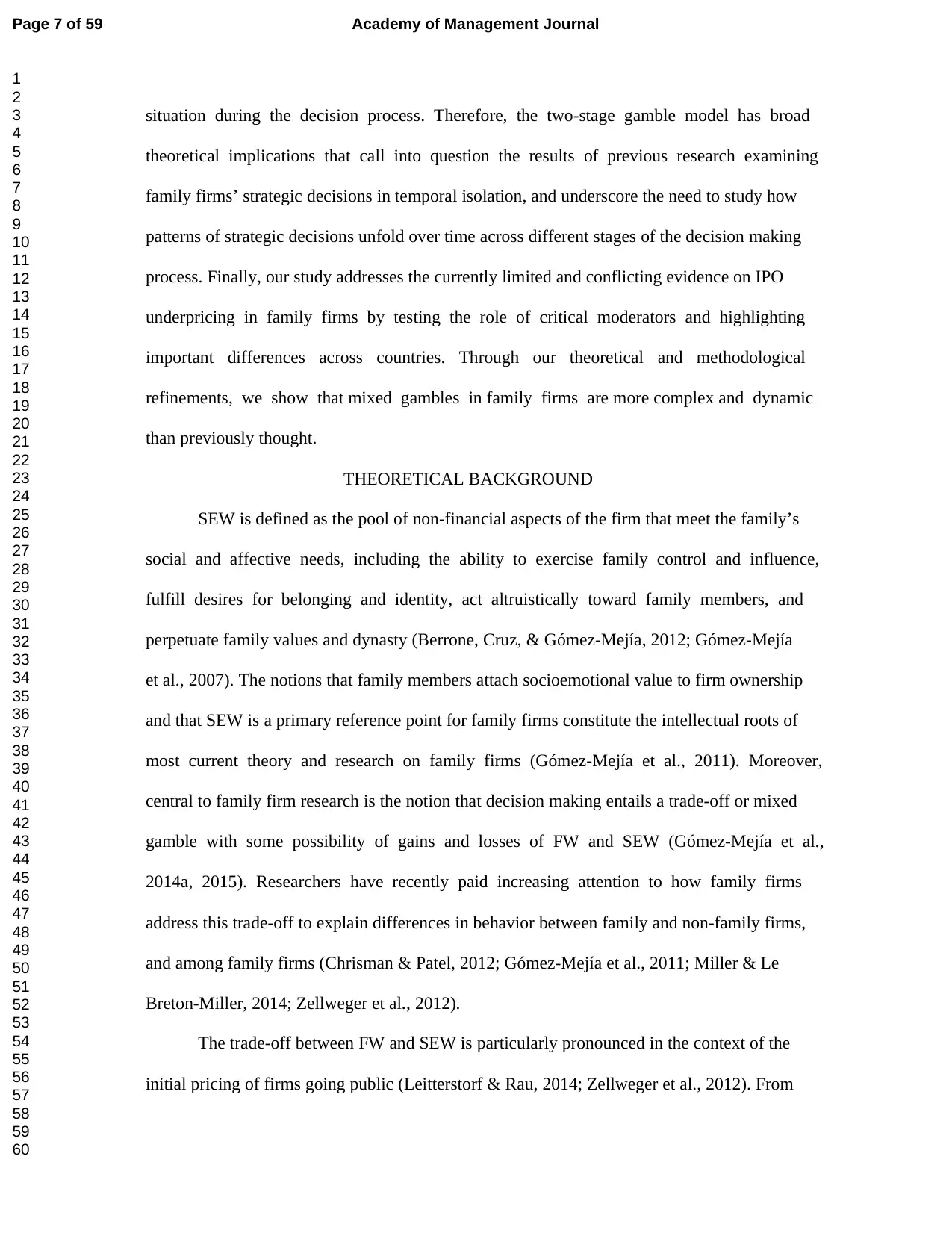
situation during the decision process. Therefore, the two-stage gamble model has broad
theoretical implications that call into question the results of previous research examining
family firms’ strategic decisions in temporal isolation, and underscore the need to study how
patterns of strategic decisions unfold over time across different stages of the decision making
process. Finally, our study addresses the currently limited and conflicting evidence on IPO
underpricing in family firms by testing the role of critical moderators and highlighting
important differences across countries. Through our theoretical and methodological
refinements, we show that mixed gambles in family firms are more complex and dynamic
than previously thought.
THEORETICAL BACKGROUND
SEW is defined as the pool of non-financial aspects of the firm that meet the family’s
social and affective needs, including the ability to exercise family control and influence,
fulfill desires for belonging and identity, act altruistically toward family members, and
perpetuate family values and dynasty (Berrone, Cruz, & Gómez-Mejía, 2012; Gómez-Mejía
et al., 2007). The notions that family members attach socioemotional value to firm ownership
and that SEW is a primary reference point for family firms constitute the intellectual roots of
most current theory and research on family firms (Gómez-Mejía et al., 2011). Moreover,
central to family firm research is the notion that decision making entails a trade-off or mixed
gamble with some possibility of gains and losses of FW and SEW (Gómez-Mejía et al.,
2014a, 2015). Researchers have recently paid increasing attention to how family firms
address this trade-off to explain differences in behavior between family and non-family firms,
and among family firms (Chrisman & Patel, 2012; Gómez-Mejía et al., 2011; Miller & Le
Breton-Miller, 2014; Zellweger et al., 2012).
The trade-off between FW and SEW is particularly pronounced in the context of the
initial pricing of firms going public (Leitterstorf & Rau, 2014; Zellweger et al., 2012). From
Page 7 of 59 Academy of Management Journal
1
2
3
4
5
6
7
8
9
10
11
12
13
14
15
16
17
18
19
20
21
22
23
24
25
26
27
28
29
30
31
32
33
34
35
36
37
38
39
40
41
42
43
44
45
46
47
48
49
50
51
52
53
54
55
56
57
58
59
60
theoretical implications that call into question the results of previous research examining
family firms’ strategic decisions in temporal isolation, and underscore the need to study how
patterns of strategic decisions unfold over time across different stages of the decision making
process. Finally, our study addresses the currently limited and conflicting evidence on IPO
underpricing in family firms by testing the role of critical moderators and highlighting
important differences across countries. Through our theoretical and methodological
refinements, we show that mixed gambles in family firms are more complex and dynamic
than previously thought.
THEORETICAL BACKGROUND
SEW is defined as the pool of non-financial aspects of the firm that meet the family’s
social and affective needs, including the ability to exercise family control and influence,
fulfill desires for belonging and identity, act altruistically toward family members, and
perpetuate family values and dynasty (Berrone, Cruz, & Gómez-Mejía, 2012; Gómez-Mejía
et al., 2007). The notions that family members attach socioemotional value to firm ownership
and that SEW is a primary reference point for family firms constitute the intellectual roots of
most current theory and research on family firms (Gómez-Mejía et al., 2011). Moreover,
central to family firm research is the notion that decision making entails a trade-off or mixed
gamble with some possibility of gains and losses of FW and SEW (Gómez-Mejía et al.,
2014a, 2015). Researchers have recently paid increasing attention to how family firms
address this trade-off to explain differences in behavior between family and non-family firms,
and among family firms (Chrisman & Patel, 2012; Gómez-Mejía et al., 2011; Miller & Le
Breton-Miller, 2014; Zellweger et al., 2012).
The trade-off between FW and SEW is particularly pronounced in the context of the
initial pricing of firms going public (Leitterstorf & Rau, 2014; Zellweger et al., 2012). From
Page 7 of 59 Academy of Management Journal
1
2
3
4
5
6
7
8
9
10
11
12
13
14
15
16
17
18
19
20
21
22
23
24
25
26
27
28
29
30
31
32
33
34
35
36
37
38
39
40
41
42
43
44
45
46
47
48
49
50
51
52
53
54
55
56
57
58
59
60
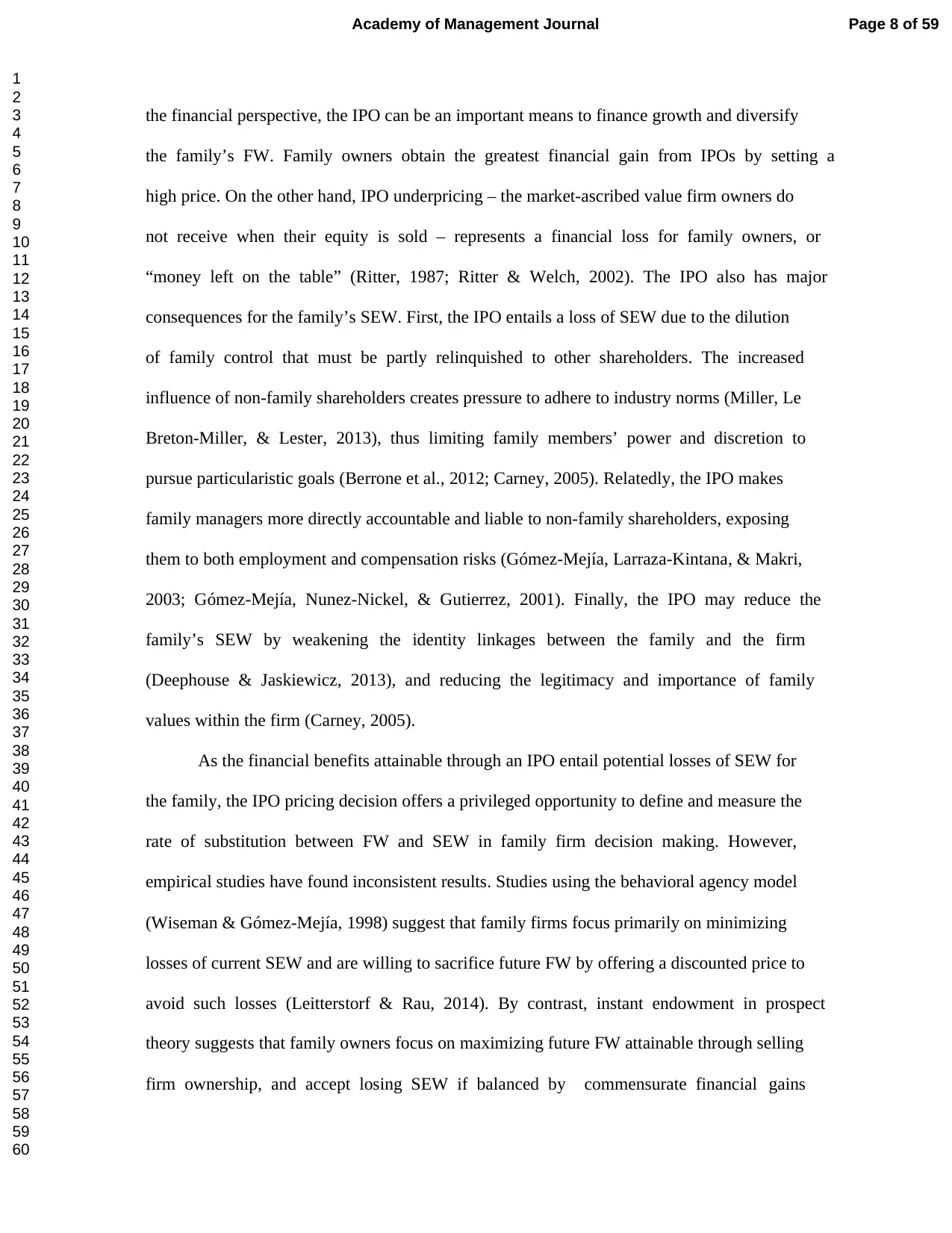
the financial perspective, the IPO can be an important means to finance growth and diversify
the family’s FW. Family owners obtain the greatest financial gain from IPOs by setting a
high price. On the other hand, IPO underpricing – the market-ascribed value firm owners do
not receive when their equity is sold – represents a financial loss for family owners, or
“money left on the table” (Ritter, 1987; Ritter & Welch, 2002). The IPO also has major
consequences for the family’s SEW. First, the IPO entails a loss of SEW due to the dilution
of family control that must be partly relinquished to other shareholders. The increased
influence of non-family shareholders creates pressure to adhere to industry norms (Miller, Le
Breton-Miller, & Lester, 2013), thus limiting family members’ power and discretion to
pursue particularistic goals (Berrone et al., 2012; Carney, 2005). Relatedly, the IPO makes
family managers more directly accountable and liable to non-family shareholders, exposing
them to both employment and compensation risks (Gómez-Mejía, Larraza-Kintana, & Makri,
2003; Gómez-Mejía, Nunez-Nickel, & Gutierrez, 2001). Finally, the IPO may reduce the
family’s SEW by weakening the identity linkages between the family and the firm
(Deephouse & Jaskiewicz, 2013), and reducing the legitimacy and importance of family
values within the firm (Carney, 2005).
As the financial benefits attainable through an IPO entail potential losses of SEW for
the family, the IPO pricing decision offers a privileged opportunity to define and measure the
rate of substitution between FW and SEW in family firm decision making. However,
empirical studies have found inconsistent results. Studies using the behavioral agency model
(Wiseman & Gómez-Mejía, 1998) suggest that family firms focus primarily on minimizing
losses of current SEW and are willing to sacrifice future FW by offering a discounted price to
avoid such losses (Leitterstorf & Rau, 2014). By contrast, instant endowment in prospect
theory suggests that family owners focus on maximizing future FW attainable through selling
firm ownership, and accept losing SEW if balanced by commensurate financial gains
Page 8 of 59Academy of Management Journal
1
2
3
4
5
6
7
8
9
10
11
12
13
14
15
16
17
18
19
20
21
22
23
24
25
26
27
28
29
30
31
32
33
34
35
36
37
38
39
40
41
42
43
44
45
46
47
48
49
50
51
52
53
54
55
56
57
58
59
60
the family’s FW. Family owners obtain the greatest financial gain from IPOs by setting a
high price. On the other hand, IPO underpricing – the market-ascribed value firm owners do
not receive when their equity is sold – represents a financial loss for family owners, or
“money left on the table” (Ritter, 1987; Ritter & Welch, 2002). The IPO also has major
consequences for the family’s SEW. First, the IPO entails a loss of SEW due to the dilution
of family control that must be partly relinquished to other shareholders. The increased
influence of non-family shareholders creates pressure to adhere to industry norms (Miller, Le
Breton-Miller, & Lester, 2013), thus limiting family members’ power and discretion to
pursue particularistic goals (Berrone et al., 2012; Carney, 2005). Relatedly, the IPO makes
family managers more directly accountable and liable to non-family shareholders, exposing
them to both employment and compensation risks (Gómez-Mejía, Larraza-Kintana, & Makri,
2003; Gómez-Mejía, Nunez-Nickel, & Gutierrez, 2001). Finally, the IPO may reduce the
family’s SEW by weakening the identity linkages between the family and the firm
(Deephouse & Jaskiewicz, 2013), and reducing the legitimacy and importance of family
values within the firm (Carney, 2005).
As the financial benefits attainable through an IPO entail potential losses of SEW for
the family, the IPO pricing decision offers a privileged opportunity to define and measure the
rate of substitution between FW and SEW in family firm decision making. However,
empirical studies have found inconsistent results. Studies using the behavioral agency model
(Wiseman & Gómez-Mejía, 1998) suggest that family firms focus primarily on minimizing
losses of current SEW and are willing to sacrifice future FW by offering a discounted price to
avoid such losses (Leitterstorf & Rau, 2014). By contrast, instant endowment in prospect
theory suggests that family owners focus on maximizing future FW attainable through selling
firm ownership, and accept losing SEW if balanced by commensurate financial gains
Page 8 of 59Academy of Management Journal
1
2
3
4
5
6
7
8
9
10
11
12
13
14
15
16
17
18
19
20
21
22
23
24
25
26
27
28
29
30
31
32
33
34
35
36
37
38
39
40
41
42
43
44
45
46
47
48
49
50
51
52
53
54
55
56
57
58
59
60
⊘ This is a preview!⊘
Do you want full access?
Subscribe today to unlock all pages.

Trusted by 1+ million students worldwide
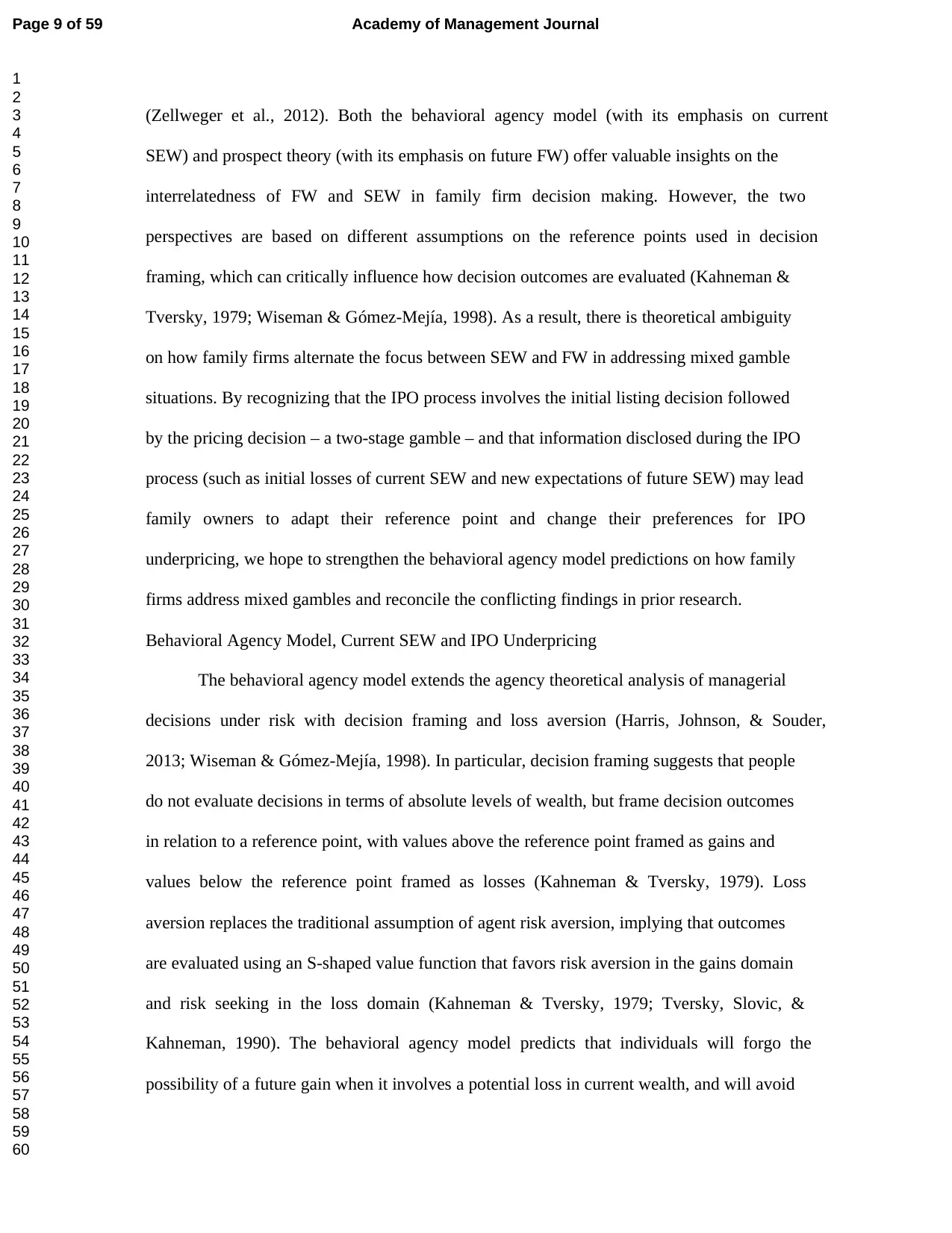
(Zellweger et al., 2012). Both the behavioral agency model (with its emphasis on current
SEW) and prospect theory (with its emphasis on future FW) offer valuable insights on the
interrelatedness of FW and SEW in family firm decision making. However, the two
perspectives are based on different assumptions on the reference points used in decision
framing, which can critically influence how decision outcomes are evaluated (Kahneman &
Tversky, 1979; Wiseman & Gómez-Mejía, 1998). As a result, there is theoretical ambiguity
on how family firms alternate the focus between SEW and FW in addressing mixed gamble
situations. By recognizing that the IPO process involves the initial listing decision followed
by the pricing decision – a two-stage gamble – and that information disclosed during the IPO
process (such as initial losses of current SEW and new expectations of future SEW) may lead
family owners to adapt their reference point and change their preferences for IPO
underpricing, we hope to strengthen the behavioral agency model predictions on how family
firms address mixed gambles and reconcile the conflicting findings in prior research.
Behavioral Agency Model, Current SEW and IPO Underpricing
The behavioral agency model extends the agency theoretical analysis of managerial
decisions under risk with decision framing and loss aversion (Harris, Johnson, & Souder,
2013; Wiseman & Gómez-Mejía, 1998). In particular, decision framing suggests that people
do not evaluate decisions in terms of absolute levels of wealth, but frame decision outcomes
in relation to a reference point, with values above the reference point framed as gains and
values below the reference point framed as losses (Kahneman & Tversky, 1979). Loss
aversion replaces the traditional assumption of agent risk aversion, implying that outcomes
are evaluated using an S-shaped value function that favors risk aversion in the gains domain
and risk seeking in the loss domain (Kahneman & Tversky, 1979; Tversky, Slovic, &
Kahneman, 1990). The behavioral agency model predicts that individuals will forgo the
possibility of a future gain when it involves a potential loss in current wealth, and will avoid
Page 9 of 59 Academy of Management Journal
1
2
3
4
5
6
7
8
9
10
11
12
13
14
15
16
17
18
19
20
21
22
23
24
25
26
27
28
29
30
31
32
33
34
35
36
37
38
39
40
41
42
43
44
45
46
47
48
49
50
51
52
53
54
55
56
57
58
59
60
SEW) and prospect theory (with its emphasis on future FW) offer valuable insights on the
interrelatedness of FW and SEW in family firm decision making. However, the two
perspectives are based on different assumptions on the reference points used in decision
framing, which can critically influence how decision outcomes are evaluated (Kahneman &
Tversky, 1979; Wiseman & Gómez-Mejía, 1998). As a result, there is theoretical ambiguity
on how family firms alternate the focus between SEW and FW in addressing mixed gamble
situations. By recognizing that the IPO process involves the initial listing decision followed
by the pricing decision – a two-stage gamble – and that information disclosed during the IPO
process (such as initial losses of current SEW and new expectations of future SEW) may lead
family owners to adapt their reference point and change their preferences for IPO
underpricing, we hope to strengthen the behavioral agency model predictions on how family
firms address mixed gambles and reconcile the conflicting findings in prior research.
Behavioral Agency Model, Current SEW and IPO Underpricing
The behavioral agency model extends the agency theoretical analysis of managerial
decisions under risk with decision framing and loss aversion (Harris, Johnson, & Souder,
2013; Wiseman & Gómez-Mejía, 1998). In particular, decision framing suggests that people
do not evaluate decisions in terms of absolute levels of wealth, but frame decision outcomes
in relation to a reference point, with values above the reference point framed as gains and
values below the reference point framed as losses (Kahneman & Tversky, 1979). Loss
aversion replaces the traditional assumption of agent risk aversion, implying that outcomes
are evaluated using an S-shaped value function that favors risk aversion in the gains domain
and risk seeking in the loss domain (Kahneman & Tversky, 1979; Tversky, Slovic, &
Kahneman, 1990). The behavioral agency model predicts that individuals will forgo the
possibility of a future gain when it involves a potential loss in current wealth, and will avoid
Page 9 of 59 Academy of Management Journal
1
2
3
4
5
6
7
8
9
10
11
12
13
14
15
16
17
18
19
20
21
22
23
24
25
26
27
28
29
30
31
32
33
34
35
36
37
38
39
40
41
42
43
44
45
46
47
48
49
50
51
52
53
54
55
56
57
58
59
60
Paraphrase This Document
Need a fresh take? Get an instant paraphrase of this document with our AI Paraphraser
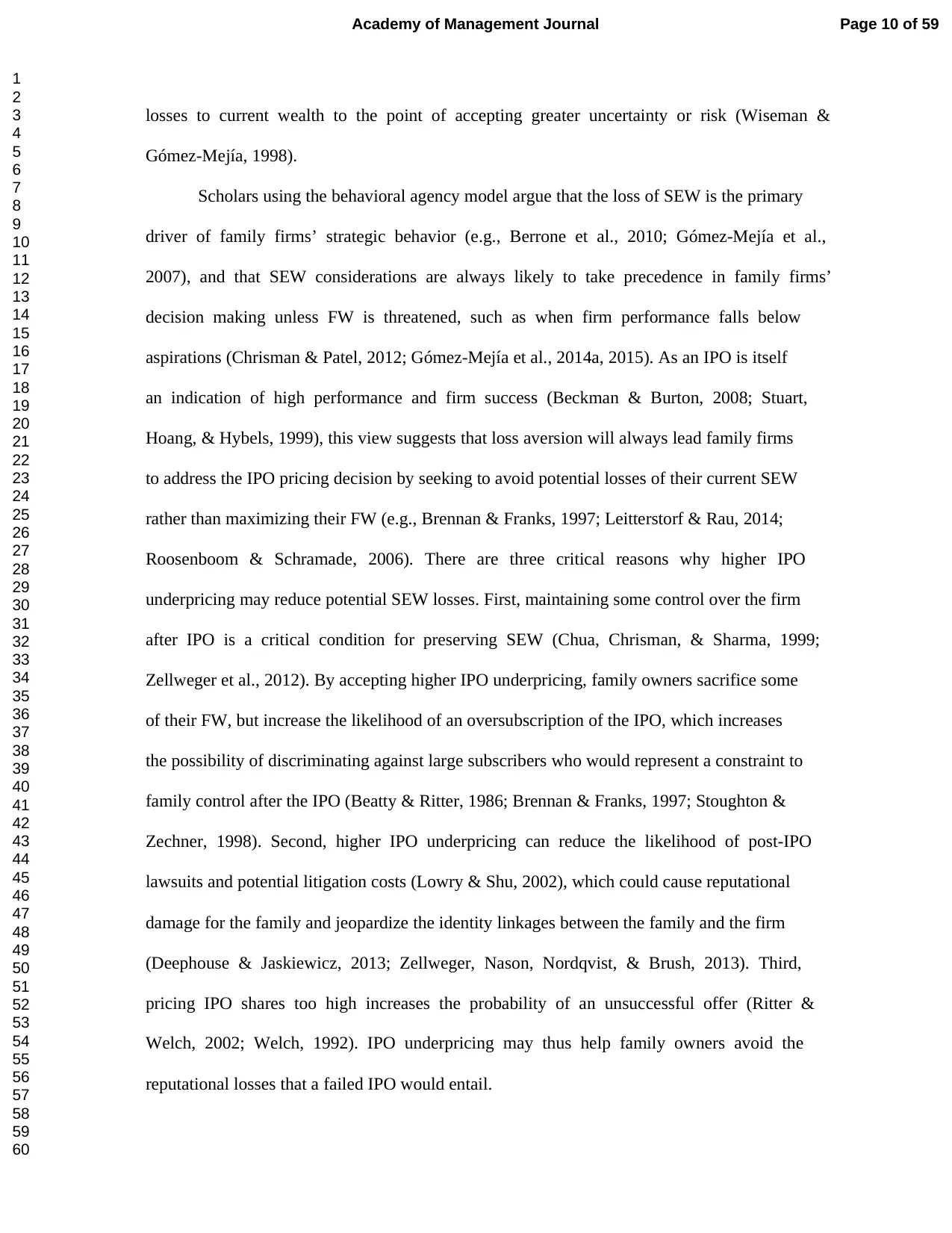
losses to current wealth to the point of accepting greater uncertainty or risk (Wiseman &
Gómez-Mejía, 1998).
Scholars using the behavioral agency model argue that the loss of SEW is the primary
driver of family firms’ strategic behavior (e.g., Berrone et al., 2010; Gómez-Mejía et al.,
2007), and that SEW considerations are always likely to take precedence in family firms’
decision making unless FW is threatened, such as when firm performance falls below
aspirations (Chrisman & Patel, 2012; Gómez-Mejía et al., 2014a, 2015). As an IPO is itself
an indication of high performance and firm success (Beckman & Burton, 2008; Stuart,
Hoang, & Hybels, 1999), this view suggests that loss aversion will always lead family firms
to address the IPO pricing decision by seeking to avoid potential losses of their current SEW
rather than maximizing their FW (e.g., Brennan & Franks, 1997; Leitterstorf & Rau, 2014;
Roosenboom & Schramade, 2006). There are three critical reasons why higher IPO
underpricing may reduce potential SEW losses. First, maintaining some control over the firm
after IPO is a critical condition for preserving SEW (Chua, Chrisman, & Sharma, 1999;
Zellweger et al., 2012). By accepting higher IPO underpricing, family owners sacrifice some
of their FW, but increase the likelihood of an oversubscription of the IPO, which increases
the possibility of discriminating against large subscribers who would represent a constraint to
family control after the IPO (Beatty & Ritter, 1986; Brennan & Franks, 1997; Stoughton &
Zechner, 1998). Second, higher IPO underpricing can reduce the likelihood of post-IPO
lawsuits and potential litigation costs (Lowry & Shu, 2002), which could cause reputational
damage for the family and jeopardize the identity linkages between the family and the firm
(Deephouse & Jaskiewicz, 2013; Zellweger, Nason, Nordqvist, & Brush, 2013). Third,
pricing IPO shares too high increases the probability of an unsuccessful offer (Ritter &
Welch, 2002; Welch, 1992). IPO underpricing may thus help family owners avoid the
reputational losses that a failed IPO would entail.
Page 10 of 59Academy of Management Journal
1
2
3
4
5
6
7
8
9
10
11
12
13
14
15
16
17
18
19
20
21
22
23
24
25
26
27
28
29
30
31
32
33
34
35
36
37
38
39
40
41
42
43
44
45
46
47
48
49
50
51
52
53
54
55
56
57
58
59
60
Gómez-Mejía, 1998).
Scholars using the behavioral agency model argue that the loss of SEW is the primary
driver of family firms’ strategic behavior (e.g., Berrone et al., 2010; Gómez-Mejía et al.,
2007), and that SEW considerations are always likely to take precedence in family firms’
decision making unless FW is threatened, such as when firm performance falls below
aspirations (Chrisman & Patel, 2012; Gómez-Mejía et al., 2014a, 2015). As an IPO is itself
an indication of high performance and firm success (Beckman & Burton, 2008; Stuart,
Hoang, & Hybels, 1999), this view suggests that loss aversion will always lead family firms
to address the IPO pricing decision by seeking to avoid potential losses of their current SEW
rather than maximizing their FW (e.g., Brennan & Franks, 1997; Leitterstorf & Rau, 2014;
Roosenboom & Schramade, 2006). There are three critical reasons why higher IPO
underpricing may reduce potential SEW losses. First, maintaining some control over the firm
after IPO is a critical condition for preserving SEW (Chua, Chrisman, & Sharma, 1999;
Zellweger et al., 2012). By accepting higher IPO underpricing, family owners sacrifice some
of their FW, but increase the likelihood of an oversubscription of the IPO, which increases
the possibility of discriminating against large subscribers who would represent a constraint to
family control after the IPO (Beatty & Ritter, 1986; Brennan & Franks, 1997; Stoughton &
Zechner, 1998). Second, higher IPO underpricing can reduce the likelihood of post-IPO
lawsuits and potential litigation costs (Lowry & Shu, 2002), which could cause reputational
damage for the family and jeopardize the identity linkages between the family and the firm
(Deephouse & Jaskiewicz, 2013; Zellweger, Nason, Nordqvist, & Brush, 2013). Third,
pricing IPO shares too high increases the probability of an unsuccessful offer (Ritter &
Welch, 2002; Welch, 1992). IPO underpricing may thus help family owners avoid the
reputational losses that a failed IPO would entail.
Page 10 of 59Academy of Management Journal
1
2
3
4
5
6
7
8
9
10
11
12
13
14
15
16
17
18
19
20
21
22
23
24
25
26
27
28
29
30
31
32
33
34
35
36
37
38
39
40
41
42
43
44
45
46
47
48
49
50
51
52
53
54
55
56
57
58
59
60
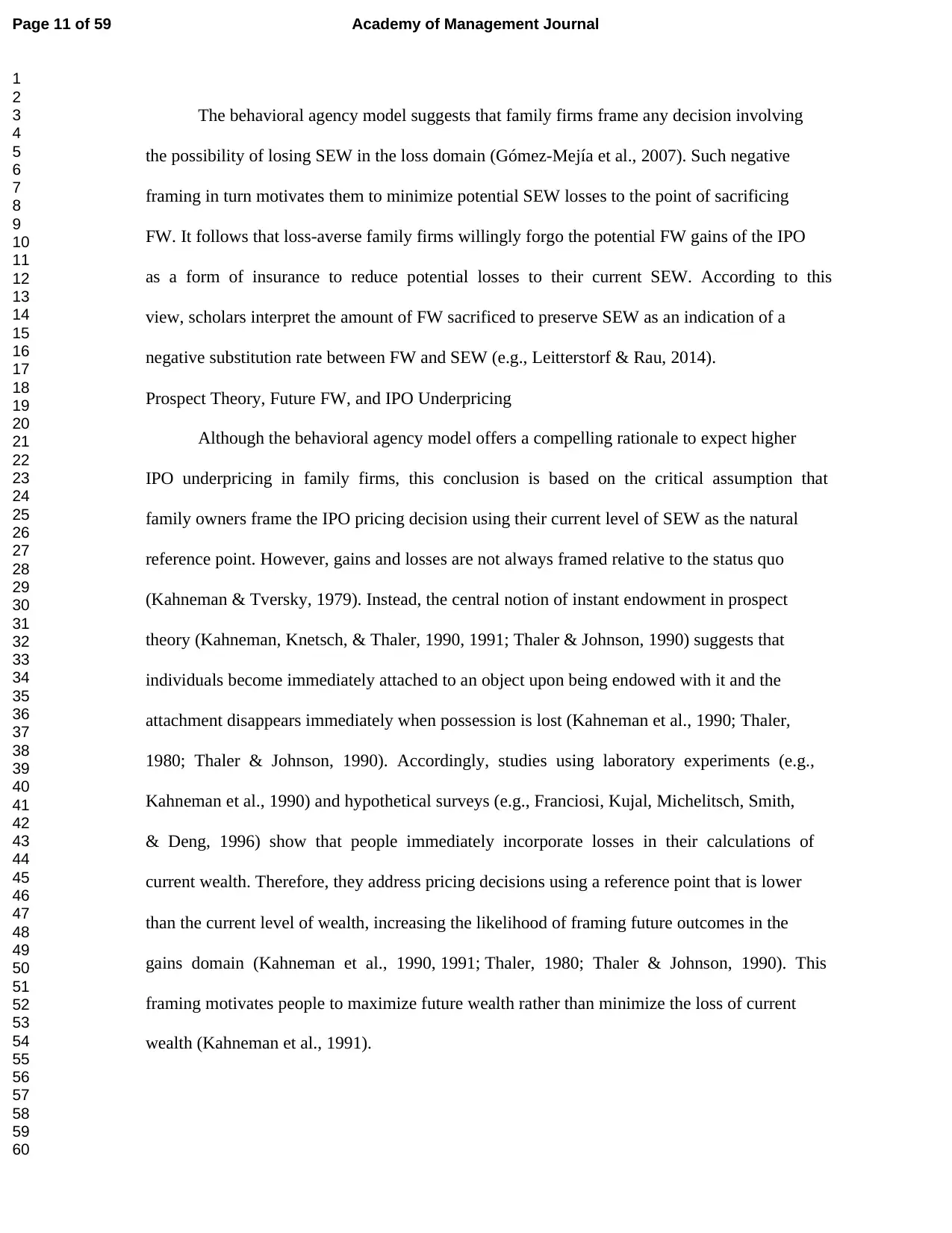
The behavioral agency model suggests that family firms frame any decision involving
the possibility of losing SEW in the loss domain (Gómez-Mejía et al., 2007). Such negative
framing in turn motivates them to minimize potential SEW losses to the point of sacrificing
FW. It follows that loss-averse family firms willingly forgo the potential FW gains of the IPO
as a form of insurance to reduce potential losses to their current SEW. According to this
view, scholars interpret the amount of FW sacrificed to preserve SEW as an indication of a
negative substitution rate between FW and SEW (e.g., Leitterstorf & Rau, 2014).
Prospect Theory, Future FW, and IPO Underpricing
Although the behavioral agency model offers a compelling rationale to expect higher
IPO underpricing in family firms, this conclusion is based on the critical assumption that
family owners frame the IPO pricing decision using their current level of SEW as the natural
reference point. However, gains and losses are not always framed relative to the status quo
(Kahneman & Tversky, 1979). Instead, the central notion of instant endowment in prospect
theory (Kahneman, Knetsch, & Thaler, 1990, 1991; Thaler & Johnson, 1990) suggests that
individuals become immediately attached to an object upon being endowed with it and the
attachment disappears immediately when possession is lost (Kahneman et al., 1990; Thaler,
1980; Thaler & Johnson, 1990). Accordingly, studies using laboratory experiments (e.g.,
Kahneman et al., 1990) and hypothetical surveys (e.g., Franciosi, Kujal, Michelitsch, Smith,
& Deng, 1996) show that people immediately incorporate losses in their calculations of
current wealth. Therefore, they address pricing decisions using a reference point that is lower
than the current level of wealth, increasing the likelihood of framing future outcomes in the
gains domain (Kahneman et al., 1990, 1991; Thaler, 1980; Thaler & Johnson, 1990). This
framing motivates people to maximize future wealth rather than minimize the loss of current
wealth (Kahneman et al., 1991).
Page 11 of 59 Academy of Management Journal
1
2
3
4
5
6
7
8
9
10
11
12
13
14
15
16
17
18
19
20
21
22
23
24
25
26
27
28
29
30
31
32
33
34
35
36
37
38
39
40
41
42
43
44
45
46
47
48
49
50
51
52
53
54
55
56
57
58
59
60
the possibility of losing SEW in the loss domain (Gómez-Mejía et al., 2007). Such negative
framing in turn motivates them to minimize potential SEW losses to the point of sacrificing
FW. It follows that loss-averse family firms willingly forgo the potential FW gains of the IPO
as a form of insurance to reduce potential losses to their current SEW. According to this
view, scholars interpret the amount of FW sacrificed to preserve SEW as an indication of a
negative substitution rate between FW and SEW (e.g., Leitterstorf & Rau, 2014).
Prospect Theory, Future FW, and IPO Underpricing
Although the behavioral agency model offers a compelling rationale to expect higher
IPO underpricing in family firms, this conclusion is based on the critical assumption that
family owners frame the IPO pricing decision using their current level of SEW as the natural
reference point. However, gains and losses are not always framed relative to the status quo
(Kahneman & Tversky, 1979). Instead, the central notion of instant endowment in prospect
theory (Kahneman, Knetsch, & Thaler, 1990, 1991; Thaler & Johnson, 1990) suggests that
individuals become immediately attached to an object upon being endowed with it and the
attachment disappears immediately when possession is lost (Kahneman et al., 1990; Thaler,
1980; Thaler & Johnson, 1990). Accordingly, studies using laboratory experiments (e.g.,
Kahneman et al., 1990) and hypothetical surveys (e.g., Franciosi, Kujal, Michelitsch, Smith,
& Deng, 1996) show that people immediately incorporate losses in their calculations of
current wealth. Therefore, they address pricing decisions using a reference point that is lower
than the current level of wealth, increasing the likelihood of framing future outcomes in the
gains domain (Kahneman et al., 1990, 1991; Thaler, 1980; Thaler & Johnson, 1990). This
framing motivates people to maximize future wealth rather than minimize the loss of current
wealth (Kahneman et al., 1991).
Page 11 of 59 Academy of Management Journal
1
2
3
4
5
6
7
8
9
10
11
12
13
14
15
16
17
18
19
20
21
22
23
24
25
26
27
28
29
30
31
32
33
34
35
36
37
38
39
40
41
42
43
44
45
46
47
48
49
50
51
52
53
54
55
56
57
58
59
60
⊘ This is a preview!⊘
Do you want full access?
Subscribe today to unlock all pages.

Trusted by 1+ million students worldwide
1 out of 60
Your All-in-One AI-Powered Toolkit for Academic Success.
+13062052269
info@desklib.com
Available 24*7 on WhatsApp / Email
![[object Object]](/_next/static/media/star-bottom.7253800d.svg)
Unlock your academic potential
Copyright © 2020–2025 A2Z Services. All Rights Reserved. Developed and managed by ZUCOL.